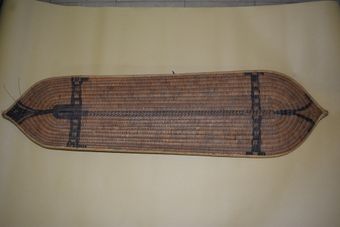Solomon Islands National Museum
Based in Honiara, we are one of the oldest cultural institutions in the Solomon Islands. Our mission is to collect, preserve, protect, safeguard, record, and promote the tangible and intangible cultural heritage of the Solomon Islands.
Showing 119 items from Solomon Islands National Museum
Filter by
-
 Kwara’ae measurements for shell-moneySolomon Islands National MuseumText Solomon Islands Online
Kwara’ae measurements for shell-moneySolomon Islands National MuseumText Solomon Islands Online -
 Land Rights and Development: Writing about Kwara'ae traditionSolomon Islands National MuseumText Solomon Islands Online
Land Rights and Development: Writing about Kwara'ae traditionSolomon Islands National MuseumText Solomon Islands Online -
 Culture, Kastom, Tradition : Developing Cultural Policy in MelanesiaSolomon Islands National MuseumText Solomon Islands Online
Culture, Kastom, Tradition : Developing Cultural Policy in MelanesiaSolomon Islands National MuseumText Solomon Islands Online -
 Remembering the Pacific WarSolomon Islands National MuseumText Solomon Islands Online
Remembering the Pacific WarSolomon Islands National MuseumText Solomon Islands Online -
 The South Sea Islanders and the Queensland labour tradeSolomon Islands National MuseumText Solomon Islands Online
The South Sea Islanders and the Queensland labour tradeSolomon Islands National MuseumText Solomon Islands Online -
 Passage, Port and Plantation: A history of Solomon Island labour migration, 1870 - 1914Solomon Islands National MuseumText Solomon Islands Online
Passage, Port and Plantation: A history of Solomon Island labour migration, 1870 - 1914Solomon Islands National MuseumText Solomon Islands Online -
Pacific History Journal BibliographySolomon Islands National MuseumType Unknown Solomon Islands Online
-
 Select Bibliography on Solomon Islands, 2003–2017Solomon Islands National MuseumText Solomon Islands Online
Select Bibliography on Solomon Islands, 2003–2017Solomon Islands National MuseumText Solomon Islands Online -
 Solomon Islands National Museum Objects & ArtifactsCurrency/Ring (Bakiha)Solomon Islands National MuseumObject Solomon Islands Online
Solomon Islands National Museum Objects & ArtifactsCurrency/Ring (Bakiha)Solomon Islands National MuseumObject Solomon Islands Online -
 Solomon Islands National Museum Objects & ArtifactsFish Trap.- Vubu (wubu)Solomon Islands National MuseumObject Solomon Islands Online
Solomon Islands National Museum Objects & ArtifactsFish Trap.- Vubu (wubu)Solomon Islands National MuseumObject Solomon Islands Online -
 Solomon Islands National Museum Objects & ArtifactsStone bowl (Kato)Solomon Islands National MuseumObject Solomon Islands Online
Solomon Islands National Museum Objects & ArtifactsStone bowl (Kato)Solomon Islands National MuseumObject Solomon Islands Online -
 Solomon Islands National Museum Objects & ArtifactsShield (‘LAVE’)Solomon Islands National MuseumObject Solomon Islands Online
Solomon Islands National Museum Objects & ArtifactsShield (‘LAVE’)Solomon Islands National MuseumObject Solomon Islands Online
Results per page
Solomon Islands National Museum
Welcome and warm Pasifik greetings
The information on this site has been gathered from our content partners.
The names, terms, and labels that we present on the site may contain images or voices of deceased persons and may also reflect the bias, norms, and perspective of the period of time in which they were created. We accept that these may not be appropriate today.
If you have any concerns or questions about an item, please contact us.